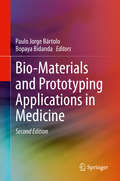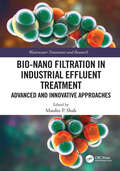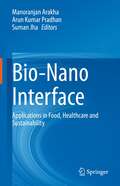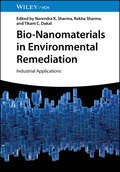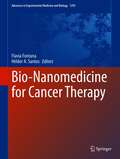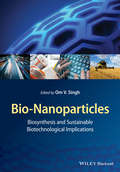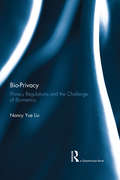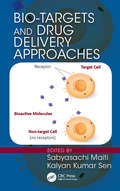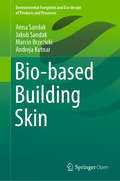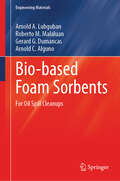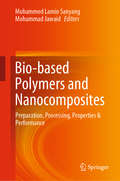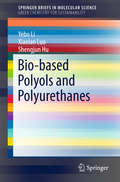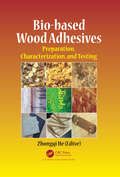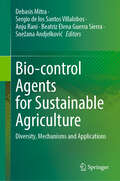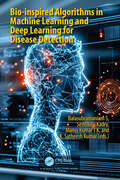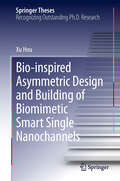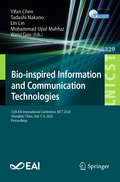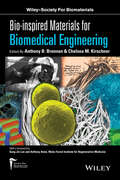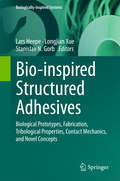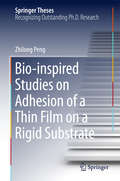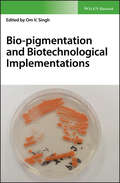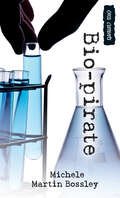- Table View
- List View
Bio-Materials and Prototyping Applications in Medicine
by Paulo Jorge Bártolo Bopaya BidandaRapid prototyping is used to design and develop medical devices and instrumentation. This book details research in rapid prototyping of bio-materials for medical applications. It provides a wide variety of examples of medical applications using rapid prototyping, including tissue engineering, dental applications, and bone replacement. Coverage also discusses the emergence of computer aided design in the development of prosthetic devices.
Bio-Nano Filtration in Industrial Effluent Treatment: Advanced and Innovative Approaches (Wastewater Treatment and Research)
by Maulin P. ShahThe ever-increasing number of pollutants discharged into the environment drives the search for new treatment technologies or the modification of the existing ones. In this sense, innovation in bio-nano filtration systems seems very promising and, therefore, a book on the current advances and innovations on this topic is highly appropriate. Bio-nano filtration is a relatively new emerging technology applied to the treatment of wastewater and other toxic compounds. In the last two decades, this technology has begun to emerge as an economically viable process to treat the great variety of recalcitrant pollutants discharged into the environment. Thus, it is speculated that the US biofiltration market will reach over $100 million by 2020. This book aims to present how innovation in bio-nano filtration can provide effective solutions to overcome the serious problem of water pollution worldwide. The removal of contaminants will be the result of the combined effects of biological oxidation, adsorption, and filtration processes. Features: Describes the microbial ecology of bio-nano filtration. Describes the modelling of bio-nano filtration. Describes the design of bio-nanofillers.
Bio-Nano Interface: Applications in Food, Healthcare and Sustainability
by Manoranjan Arakha Suman Jha Arun Kumar PradhanThis book discusses the unique interactions of nanoparticles with various biomolecules under different environmental conditions. It describes the consequences of these interactions on other biological aspects like flora and fauna of the niche, cell proliferation, etc. The book provides information about the novel and eco-friendly nanoparticle synthesis methods, such as continuous synthesis of nanoparticles using microbial cells. Additionally, the book discusses nanoparticles' potential impact in different areas of biological sciences like food, medicine, agriculture, and the environment. Due to their advanced physicochemical properties, nanoparticles have revolutionized biomedical and pharmaceutical sciences. Inside the biological milieu, nanoparticles interact with different moieties to adopt stable shape, size, and surface functionalities and form nano-biomolecular complexes. The interaction pattern at the interface form complexes determines the fate of interacting biomolecules and nanoparticles inside the biological system. Understanding the interaction pattern at the nano-bio interface is crucial for the safe use of nanoparticles in natural sciences. This book rightly addresses all questions about the interaction and the ensuing structure and function of these nano-biomolecular complexes. This book caters to students and researchers in the area of biotechnology, microbiology, and pharmaceutical sciences.
Bio-Nanomaterials in Environmental Remediation: Industrial Applications
by Rekha Sharma Narendra K. Sharma Tikam C. DakalReference on using bio-nanomaterials to remove pollution in industrial sectors ranging from food and agriculture to oil and gas Bio-Nanomaterials in Environmental Remediation discusses the application of bio-nanomaterials in various industrial settings. Bio-Nanomaterials in Environmental Remediation includes information on: Fundamentals, classification, and applications of bio-nanomaterials, technologies for the fabrication of bio-nanomaterials, and desalination of wastewater using bio-nanomaterials Applications of bio-nanomaterials in the textiles, oil, gas, food, and agriculture industries Hazard, toxicity, and monitoring standards of bio-nanomaterials Current challenges of bio-nanomaterials in industrial applications and future outlooks in the field Strategies to manage the safety of bio-nanomaterials to enable the creation of healthy and pollution-free environments Bio-Nanomaterials in Environmental Remediation is an essential up-to-date reference for professionals, researchers, and scientists working in fields where bio-nanomaterials are used.
Bio-Nanomedicine for Cancer Therapy (Advances in Experimental Medicine and Biology #1295)
by Flavia Fontana Hélder A. SantosThe book covers the latest developments in biologically-inspired and derived nanomedicine for cancer therapy. The purpose of the book is to illustrate the significance of naturally-mimicking systems for enhancing the dose delivered to the tumor, to improve stability, and prolong the circulation time. Moreover, readers are presented with advanced materials such as adjuvants for immunostimulation in cancer vaccines. The book also provides a comprehensive overview of the current status of academic research. This is an ideal book for students, researchers, and professors working in nanotechnology, cancer, targeted drug delivery, controlled drug release, materials science, and biomaterials as well as companies developing cancer immunotherapy.
Bio-Nanoparticles
by Om V. SinghNanoparticles are considered to be the building blocks for nanotechnology and are referred to as the particles having more than one dimension of the order of 100 nm or less.The nanostructured materials are being offered as better built, long lasting, cleaner, safer, and smarter products for use in communications, medicine, transportation, agriculture and other industries. Topics in molecular recognition, biomolecule-nanocrystal conjugates as fluorescence label for biological cells, and DNA-mediated groupings of nanocrystals are widespread, intriguing researchers from both biological and engineering fields. The diversity of nanotechnology covers fields from biology to material science, physics to chemistry, and other fields with variety of specialties. Controlled size, shape, composition, crystallinity, and structure-dependent properties of nanoparticles govern the unique properties of nanotechnology. The controlled biosynthesis of nanoparticles is of high scientific and technological interest as the microorganisms grab target ions from their environment and then turn the metal ions into the element metal through enzymatic mechanism generated through their cellular (Intra/ Extra) activities. The project aims to introduce the basics and advancements made so far in the field of biosynthesis of nanoparticles for graduate students and researchers around the world. The main aims are to (a) introduce the reader to the variety of microorganisms and their ability to synthesize the nanoparticles, (b) provide an overview of the methodologies applied to biosynthesize the variety of nanoparticles of medical and commercial uses, (c) provide a literature review on diversity of microorganisms able to synthesize nanoparticles of different types, (d) to discuss the regulatory mechanisms in microorganism able to synthesize variety of nanoparticles, (e) discuss experimental design problems associated with the controlled biosynthesis of nanoparticles, (f) discuss the stability and toxicity of nanoparticles in varying environment towards their therapeutic implications. The regulations, challenges and implications of biosynthesized nanoparticles for commercial significance will also represent among the main sections of the book. These aims will be organized by invited research/ review articles from renowned researchers exploring biosynthesis of variety of nanoparticles, and differ in length and number of chapters, with the literature review section containing the bulk of the text.
Bio-Privacy: Privacy Regulations and the Challenge of Biometrics
by Nancy Yue LiuBio-Privacy: Privacy Regulations and the Challenge of Biometrics provides an in-depth consideration of the legal issues posed by the use of biometric technology. Focusing particularly on the relationship between the use of this technology and the protection of privacy, this book draws on material across a range of jurisdictions in order to explore several key questions. What are the privacy issues in the biometric context? How are these issues currently dealt with under the law? What principles are applied? Is the current regulation satisfactory? Is it applied consistently? And, more generally, what is the most appropriate way to deal with the legal implications of biometrics? Offering an analysis, and recommendations, with a view to securing adequate human rights and personal data protection, Bio-Privacy: Privacy Regulations and the Challenge of Biometrics will be an important reference point for those with interests in the tension between freedom and security.
Bio-Targets and Drug Delivery Approaches
by Sabyasachi Maiti and Kalyan Kumar SenThe advances in drug delivery systems over recent years have resulted in a large number of novel delivery systems with the potential to revolutionize the treatment and prevention of diseases. Bio-Targets and Drug Delivery Approaches is an easy-to-read book for students, researchers and pharmaceutical scientists providing a comprehensive introduction to the principles of advanced drug delivery and targeting their current applications and potential future developments.
Bio-based Building Skin (Environmental Footprints and Eco-design of Products and Processes)
by Andreja Kutnar Anna Sandak Jakub Sandak Marcin BrzezickiThis book provides a compendium of material properties, demonstrates several successful examples of bio-based materials’ application in building facades, and offers ideas for new designs and novel solutions. It features a state-of-the-art review, addresses the latest trends in material selection, assembling systems, and innovative functions of facades in detail. Selected case studies on buildings from diverse locations are subsequently presented to demonstrate the successful implementation of various biomaterial solutions, which defines unique architectural styles and building functions. The structures, morphologies and aesthetic impressions related to bio-based building facades are discussed from the perspective of art and innovation; essential factors influencing the performance of materials with respect to functionality and safety are also presented. Special emphasis is placed on assessing the performance of a given facade throughout the service life of a building, and after its end. The book not only provides an excellent source of technical and scientific information, but also contributes to public awareness by demonstrating the benefits to be gained from the proper use of bio-based materials in facades. As such, it will appeal to a broad audience including architects, engineers, designers and building contractors.
Bio-based Foam Sorbents: For Oil Spill Cleanups (Engineering Materials)
by Arnold A. Lubguban Roberto M. Malaluan Gerard G. Dumancas Arnold C. AlgunoThis book highlights the advantages of using sorbents in oil spill cleanup while dealing with the challenges of limited capacity and disposal. Bio-based foam sorbents are new but promising sorbents to oil spill cleanup. They are environmentally friendly materials derived from renewable resources such as vegetable oil and biomass, designed to absorb or adsorb oil and other pollutants from water, coastal areas, wetlands, ice-covered waters, and urban surfaces. These foams offer a sustainable alternative to traditional petroleum-based sorbents, with comparable or even superior performance in oil adsorption capacity, recyclability, and biodegradability. Moreover, a bio-based foam sorbent with inherent hydrophobic property is discussed, opening a new pathway for bio-based foam sorbents that usually need surface modification. This book is a good read for environmental scientists, engineers, sustainability experts, and researchers offering insights in related to the chemistry, performance, and commercialization potential of bio-based foam sorbents. It explores various methods for synthesizing bio-based foam sorbents, providing a detailed examination of the underlying chemistry involved in these processes.
Bio-based Polymers and Nanocomposites: Preparation, Processing, Properties & Performance
by Mohammad Jawaid Muhammed Lamin Sanyang<p>This book highlights the various types of polymer and nanocomposites that can be derived from biorenewable resources. It covers various aspects of biobased polymers and nanocomposites, including preparation, processing, properties, and performance, and the latest advances in these materials. <p>It also includes recent findings from leading researchers in academia and industry, government, and private research laboratories around the globe, providing the latest information on biobased polymers and nanocomposites. Offering an overview of the entire production process, it guides readers through all stages, from the raw source materials, processing and property characterization to application performance. <p>This book is suitable for professionals and researchers seeking in-depth practical information as well as the fundamental science behind this. It also serves as a point of reference for undergraduate and graduate students, as well as postdoctoral researchers working in the area of polymer and composites with a special emphasis on biobased materials.</p>
Bio-based Polyols and Polyurethanes (SpringerBriefs in Molecular Science)
by Yebo Li Xiaolan Luo Shengjun HuThis brief outlines the most recent advances in the production of polyols and polyurethanes from renewable resources, mainly vegetable oils, lignocellulosic biomass, starch, and protein. The typical processes for the production of polyols from each of the above mentioned feedstocks are introduced and the properties of the resultant polyols and polyurethanes are also discussed.
Bio-based Superabsorbents: Recent Trends, Types, Applications and Recycling (Engineering Materials)
by Smita Mohanty Sukanya PradhanThis book examines the synthetic approaches, properties, applications, and recyclability of bio-based superabsorbent polymers (SAP) in depth. It describes and compares bio-based SAPs with petro-based SAPs. Additionally, it explores the structure–property relationships of bio-based SAPs derived from various natural sources. The book covers current and emerging applications in health and hygiene products, agriculture, construction, and other areas. It also explores the recycling and reusing methods available for water recovery, pressure sensitive adhesives, etc. It discusses the issues behind the sharp increase in research attention, namely the prevailing research hotspots/clusters and suggestions with regard to present studies, works that have been significant and pivotal in the development of SAP research, and the current advances and future directions of research. It also presents the emerging applications of superabsorbent polymers.
Bio-based Wood Adhesives: Preparation, Characterization, and Testing
by Zhongqi HeAdhesive bonding plays an increasing role in the forest product industry and is a key factor for efficiently utilizing timber and other lignocellulosic resources. As synthetic wood adhesives are mostly derived from depleting petrochemical resources and have caused increasing environmental concern, natural product and byproduct-derived adhesives have attracted much attention in the last decades. Although adhesives made from plant and animal sources have been in existence since ancient times, increased knowledge of their chemistry and improved technical formulation of their preparation are still needed to promote their broader industrial applications. The primary goals of this book are to (1) synthesize the fundamental knowledge and latest research on bio-based adhesives from a remarkable range of natural products and byproducts, (2) identify need areas and provide directions of future bio-based adhesive research, and (3) help integrating research findings in practical adhesive application for maximal benefits. This book covers information on a variety of natural products and byproducts and the latest research on formulation, testing and improvement of the relevant adhesives in fifteen chapters written by an international group of accomplished contributors. This book will serve as a valuable reference source for university faculty, graduate students, research scientists, agricultural and wood engineers, international organization advocators and government agency regulators who work and deal with enhanced utilization of agricultural and forest products and byproducts.
Bio-control Agents for Sustainable Agriculture: Diversity, Mechanisms and Applications
by Debasis Mitra Sergio de los Santos Villalobos Anju Rani Beatriz Elena Guerra Sierra Snežana AndjelkovićThis book covers all aspects of the diversity and core microbiome of the bio-control agents. Their bioprospecting and application at the field level is also discussed. The application of bio-control agents is unique in plant production due to various reasons, including its environment-friendly nature, management of plant resistance and incentivizing the rhizosphere to phyllosphere signaling. The chapters provide information on major plant-associated diversity of beneficial microorganisms, various pathogen management strategies, and improving plant immunity by the application of bio-control agents. Additionally, the exploitation, development, and quality control of bio-control agent-based formulations for farming systems and industrial-level production is discussed. This approach provides a novel framework for fostering sustainable development in crop production and protection. The book targets researchers, microbiology students, the biofertilizers industry, and those in agricultural and environmental fields.
Bio-inspired Algorithms in Machine Learning and Deep Learning for Disease Detection
by Seifedine Kadry S Balasubramaniam T K Manoj Kumar K. Satheesh KumarCurrently, computational intelligence approaches are utilised in various science and engineering applications to analyse information, make decisions, and achieve optimisation goals. Over the past few decades, various techniques and algorithms have been created in disciplines such as genetic algorithms, artificial neural networks, evolutionary algorithms, and fuzzy algorithms. In the coming years, intelligent optimisation algorithms are anticipated to become more efficient in addressing various issues in engineering, scientific, medical, space, and artificial satellite fields, particularly in early disease diagnosis. A metaheuristic in computer science is designed to discover optimisation algorithms capable of solving intricate issues. Metaheuristics are optimisation algorithms that mimic biological behaviours of animals or birds and are utilised to discover the best solution for a certain problem. A meta-heuristic is an advanced approach used by heuristics to tackle intricate optimisation problems. A metaheuristic in mathematical programming is a method that seeks a solution to an optimisation problem. Metaheuristics utilise a heuristic function to assist in the search process. Heuristic search can be categorised as blind search or informed search. Meta-heuristic optimisation algorithms are gaining popularity in various applications due to their simplicity, independence from data trends, ability to find optimal solutions, and versatility across different fields. Recently, many nature-inspired computation algorithms have been utilised to diagnose people with different diseases. Nature-inspired methodologies are now widely utilised across several fields for tasks such as data analysis, decision-making, and optimisation. Techniques inspired by nature are categorised as either biology-based or natural phenomena-based. Bioinspired computing encompasses various topics in computer science, mathematics, and biology in recent years. Bio-inspired computer optimisation algorithms are a developing method that utilises concepts and inspiration from biological development to create new and resilient competitive strategies. Bio-inspired optimisation algorithms have gained recognition in machine learning and deep learning for solving complicated issues in science and engineering. Utilising BIAs learning methods with machine learning and deep learning shows great promise for accurately classifying medical conditions. This book explores the historical development of bio-inspired algorithms and their application in machine learning and deep learning models for disease diagnosis, including COVID-19, heart diseases, cancer, diabetes and some other diseases. It discusses the advantages of using bio-inspired algorithms in disease diagnosis and concludes with research directions and future prospects in this field.
Bio-inspired Asymmetric Design and Building of Biomimetic Smart Single Nanochannels (Springer Theses)
by Xu HouIn this thesis, the author introduces various bio-inspired smart nanochannel systems. A strategy for design and preparation of novel artificial responsive symmetric/asymmetric single nanochannel systems under various symmetric/asymmetric stimuli is presented for the first time. The author's research work utilizes ion track etching polymer nanochannels with different shapes as examples to demonstrate the feasibility of the design strategy for building novel artificial functional nanochannels using various symmetric/asymmetric physicochemical modifications. The development of these nanochannels and their potential applications is a burgeoning new area of research, and a number of exciting breakthroughs may be anticipated in the near future from the concepts and results reported in this thesis. Research into artificial functional nanochannels continues to drive new developments of various real-world applications, such as biosensors, energy conversion systems and nanofluidic devices. The work in this thesis has led to more than 15 publications in high-profile journals.
Bio-inspired Catalysts (Topics in Organometallic Chemistry #25)
by Thomas R. WardWith the aim of complementing well-established catalytic strategies for enantioselective catalysis, the field of artificial metalloenzymes has attracted increasing interest in the past decade. Artificial metalloenzymes result from the incorporation of a catalytically active organometallic moiety within a macromolecular host. Localization of the competent metal is ensured either by covalent, dative or supramolecular anchoring in either DNA or a protein scaffold. The properties of the resulting hybrid catalysts combine attractive features of both homogeneous and enzymatic catalysis. In particular, the optimization of such systems can be achieved both by chemical and genetic means. The book, consisting of five chapters written by leading experts, critically summarizes the state of the art in enantioselective epoxidation, sulfoxidation, fluorination, hydrogenation, allylic alkylation, Diels-Alder cycloadditions as well as Michael additions catalyzed by artificial metalloenzymes. This timely review unambiguously demonstrates the compatibility and complementarity of organometallic and enzymatic catalysis.
Bio-inspired Information and Communication Technologies: 12th EAI International Conference, BICT 2020, Shanghai, China, July 7-8, 2020, Proceedings (Lecture Notes of the Institute for Computer Sciences, Social Informatics and Telecommunications Engineering #329)
by Tadashi Nakano Lin Lin Yifan Chen Mohammad Upal Mahfuz Weisi GuoThis book constitutes the refereed conference proceedings of the 12th International Conference on Bio-inspired Information and Communications Technologies, held in Shanghai, China, in July 2020. Due to the safety concerns and travel restrictions caused by COVID-19, BICT 2020 took place online in a live stream. BICT 2020 aims to provide a world-leading and multidisciplinary venue for researchers and practitioners in diverse disciplines that seek the understanding of key principles, processes and mechanisms in biological systems and leverage those understandings to develop novel information and communications technologies (ICT). The 20 full and 8 short papers were carefully revied and selected from 56 submissions. In addition to the main track targeting broad and mainstream research topics, BICT 2020 includes four special tracks with focused research topics on internet of everything, intelligent internet of things and network applications, intelligent sensor network, and data-driven intelligent modeling, application and optimization.
Bio-inspired Information and Communications Technologies: 14th EAI International Conference, BICT 2023, Okinawa, Japan, April 11-12, 2023, Proceedings (Lecture Notes of the Institute for Computer Sciences, Social Informatics and Telecommunications Engineering #512)
by Tadashi Nakano Yifan Chen Dezhong YaoThis book constitutes the refereed conference proceedings of the 14th International Conference on Bio-inspired Information and Communications Technologies, held in Okinawa, Japan, during April 11-12, 2023. The 17 full papers were carefully reviewed and selected from 33 submissions. The papers focus on the latest research that leverages the understanding of key principles, processes, and mechanisms in biological systems for development of novel information and communications technologies (bio-inspired ICT). BICT 2023 will also highlight innovative research and technologies being developed for biomedicine that are inspired by ICT (ICT-inspired biomedicine).
Bio-inspired Materials for Biomedical Engineering
by Chelsea M. Kirschner Anthony B. BrennanThis book covers the latest bio-inspired materials synthesis techniques and biomedical applications that are advancing the field of tissue engineering. Bio-inspired concepts for biomedical engineering are at the forefront of tissue engineering and regenerative medicine. Scientists, engineers and physicians are working together to replicate the sophisticated hierarchical organization and adaptability found in nature and selected by evolution to recapitulate the cellular microenvironment. This book demonstrates the dramatic clinical breakthroughs that have been made in engineering all four of the major tissue types and modulating the immune system.Part I (Engineering Bio-inspired Material Microenvironments) covers Bio-inspired Presentation of Chemical Cues, Bio-inspired Presentation of Physical Cues, and Bio-inspired Integration of Natural Materials. Part II (Bio-inspired Tissue Engineering) addresses tissue engineering in epithelial tissue, muscle tissue, connective tissue, and the immune system.
Bio-inspired Structured Adhesives: Biological Prototypes, Fabrication, Tribological Properties, Contact Mechanics, and Novel Concepts (Biologically-Inspired Systems #9)
by Stanislav N. Gorb Lars Heepe Longjian XueThis book deals with the adhesion, friction and contact mechanics of living organisms. Further, it presents the remarkable adhesive abilities of the living organisms which inspired the design of novel micro- and nanostructured adhesives that can be used in various applications, such as climbing robots, reusable tapes, and biomedical bandages. The technologies for both the synthesis and construction of bio-inspired adhesive micro- and nanostructures, as well as their performance, are discussed in detail. Representatives of several animal groups, such as insects, spiders, tree frogs, and lizards, are able to walk on (and therefore attach to) tilted, vertical surfaces, and even ceilings in different environments. Studies have demonstrated that their highly specialized micro- and nanostructures, in combination with particular surface chemistries, are responsible for this impressive and reversible adhesion. These structures can maximize the formation of large effective contact areas on surfaces of varying roughness and chemical composition under different environmental conditions.
Bio-inspired Studies on Adhesion of a Thin Film on a Rigid Substrate (Springer Theses)
by Zhilong PengThe thesis systematically investigates the factors which influence many animals' robust adhesion abilities and micro-reversible adhesion mechanisms, including the geometric principles of their adhesion, relative humidity, surface roughness and pre-tension. Studies exploring biological adhesion mechanisms are not only of great significance for the design of advanced adhesive materials and adhesion systems for micro-climbing robots, but also very helpful for resolving the problem of adhesion failure in MEMS/NEMS.
Bio-pigmentation and Biotechnological Implementations
by Om V. SinghRecent technological advances have provided unique opportunities for the exploration of alternatives to the industrial use of chemically produced synthetic colors. The most promising developments in this area have been in bio-pigmentation derived from microorganisms. This groundbreaking book reviews the current state of the science of bio-pigmentation, providing important insights into the molecular mechanisms of microbial biosynthesis of industrial pigments. Featuring contributions by leading researchers from both industry and academe, it explores the latest advances in the use of bio-pigments as safe, sustainable alternatives to chemically synthesized pigments, and provides extensive coverage the most promising sources of bio-pigments within the food, feed, and pharmaceutical industries. • Proposes microbial uniqueness of coloration in variety of food, feed and pharmaceuticals • Covers the basic science behind bio-pigmentation as well as the latest advances in the field • Describes detection strategies for screening and identifying color producing microorganisms under varying environmental conditions • Provides an exhaustive review of the literature on color producing extremophiles and offers fascinating insights into color production as a stress response in extremophiles • Explores microbial molecular mechanisms of color production, with special coverage of color production as secondary metabolites under environmental stress Bio-pigmentation and Biotechnological Implementations is required reading for professionals and post-doctoral students of microbiology, applied microbiology, food microbiology, food science, and food biochemistry. It is a valuable working resource for scientists working in color-dependent food, feed, and pharmaceuticals.
Bio-pirate (Orca Currents)
by Michele Martin BossleyTrevor, Robyn and Nick decide they have a mystery to solve when Trevor discovers a suspicious looking young man snooping around. They learn about missing research involving the use of carob beans to aid in cancer treatment-potentially valuable information. With a shady looking grad student, a bitter activist and an employee of a medical research firm to deal with, our amateur sleuths are faced with their greatest challenge yet.
